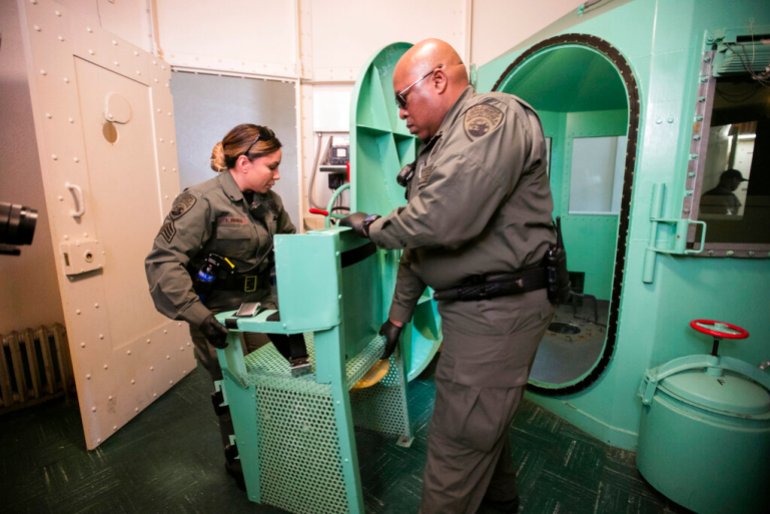California moves to dismantle US’s largest death row
The goal is to turn a section of San Quentin State Prison into a ‘positive, healing environment’, California officials say.

California Governor Gavin Newsom, who three years ago placed a moratorium on executions in the US state, is now moving to dismantle the United States’ largest death row by moving condemned inmates to other prisons within two years.
The goal is to turn the death-row section of San Quentin State Prison into a “positive, healing environment”, and Newsom said on Monday that the plan is an outgrowth of his opposition to what he believes is a deeply flawed system.
Keep reading
list of 4 itemsSierra Leone formally abolishes ‘inhumane’ death penalty
Nagaenthran case puts Singapore’s death penalty in spotlight
Sri Lanka prison chief gets death penalty for 2012 massacre
“The prospect of your ending up on death row has more to do with your wealth and race than it does your guilt or innocence,” he said. “We talk about justice, we preach justice, but as a nation, we don’t practice it on death row.”
California last carried out an execution in 2006. But it remains one of 28 states along with the US federal government that still have inmates on death rows, according to the Death Penalty Information Center.
After a 17-year hiatus, the US government carried out 13 executions under former President Donald Trump. But President Joe Biden has pledged to bring an end to executions of federal prisoners while Attorney General Merrick Garland ordered a moratorium on federal executions.
California is merging its condemned inmates into the general prison population with no expectation that any will face execution in the near future. The state of Oregon similarly transferred its much smaller condemned population to other inmate housing two years ago.

California corrections officials began a pilot programme in January 2020 that moved 116 of the state’s 673 condemned male inmates to one of seven other prisons that have maximum security facilities and are surrounded by lethal electrified fences.
“We are starting the process of closing death row to repurpose and transform the current housing units into something innovative and anchored in rehabilitation,” California Department of Corrections and Rehabilitation spokeswoman Vicky Waters said.
California prison officials intend to submit proposed regulations within weeks that would make such transfers mandatory and “allow for the repurposing of all death row housing units”, Waters said.
Newsom’s initiative cuts against a 2016 voter-approved resolution intended to speed up executions in California. “The underlying motive of the administration is to mainstream as many of these condemned murderers as possible,” said Michael Rushford, president of the Criminal Justice Legal Foundation, which backed the 2016 initiative. “Our objective was to speed up the process.”
He added that he does not think victims are happy with the administration’s decision.
“They’re moving condemned murderers into facilities that are going to make their lives better and offer them more amenities, while the victims still mourn the death of their family member,” Rushford said.
Newsom said voters approved the move, though he doubts many understood the provision. “When they affirmed the death penalty, they also affirmed a responsibility … to actually move that population on death row out and to get them working,” he said.
The ballot measure approved six years ago required condemned inmates to participate in prison jobs, with 70 percent of their money going for restitution to victims. Corrections officials said that is one of the goals with the transfers. By the end of last year, more than $49,000 in restitution had been collected under the pilot programme.
Meanwhile, Newsom’s proposed budget for the fiscal year starting July 1 seeks $1.5m to find new uses for the San Quentin prison space. It notes that death row and its supporting activities are in the same area as facilities used for rehabilitation programmes for medium-security inmates.
The public money would be used to hire a consultant to “develop options for [the] space focused on creating a positive, healing environment to provide increased rehabilitative, educational and health care opportunities”.
San Quentin’s never-used, $853,000 execution chamber is in a separate area of the prison, and there are no plans to “repurpose” that area, Waters said.
California voters supported the death penalty in 2012 and 2016, though legislative opponents have said they hope to put the issue before voters again in the coming years. The Committee on Revision of the Penal Code, an advisory panel to Newsom and lawmakers, in November recommended repealing the death penalty, calling it “beyond repair”.

Under the state’s transfer programme, condemned inmates moved to other prisons can be housed in solitary or disciplinary confinement if officials decide they cannot be safely housed with others, although they are supposed to be interspersed with other inmates.
Inmates on death row are housed one to a cell, but the transferred inmates can be housed with others if deemed safe. “There have been no safety concerns, and no major disciplinary issues have occurred,” Waters said.
When it comes to jobs and other rehabilitation activities, condemned inmates outside death row are treated similarly to inmates serving sentences of life without parole. That includes holding a variety of jobs such as maintenance and administrative duties, according to prison officials.